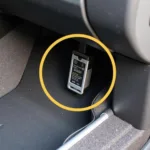The OBD2 code P0010 indicates a problem with the variable valve timing (VVT) or camshaft position (CMP) system in your vehicle, specifically on Bank 1, Camshaft 1. This code essentially signals a discrepancy between the position of the camshaft and the signal being sent to the engine control unit (ECU).
Understanding OBD2 Code P0010
Your car’s engine relies on precise timing to function correctly. The camshaft plays a crucial role in this timing by controlling the opening and closing of the engine valves. The VVT system, in modern vehicles, further optimizes this timing for improved performance and fuel efficiency.
When the ECU detects a variation between the actual camshaft position and the expected position, it logs the P0010 code. This variation can occur due to various reasons, which we’ll delve into in the next section.
Common Causes of P0010 Code
The P0010 code can be triggered by a number of issues, ranging from simple fixes to more complex mechanical problems. Here are some of the most frequent culprits:
- Faulty Camshaft Position Sensor: The CMP sensor might be malfunctioning, sending incorrect signals to the ECU.
- Worn Timing Chain/Belt: A stretched or worn timing chain or belt can disrupt the synchronization between the crankshaft and camshaft.
- Dirty Engine Oil: Contaminated or sludgy engine oil can clog the oil passages, hindering the proper function of the VVT system.
- Faulty VVT Solenoid: The VVT solenoid, responsible for regulating oil flow to the VVT actuator, can fail and cause timing issues.
- Wiring Issues: Damaged or corroded wiring within the VVT system can disrupt signal transmission.
Symptoms of a P0010 Code
Ignoring a P0010 code can lead to severe engine damage over time. Be vigilant for these symptoms, which often accompany this OBD2 code:
- Check Engine Light: The most obvious sign, indicating a problem detected by the ECU.
- Rough Engine Idle: The engine might vibrate or shake excessively when idling.
- Poor Acceleration: Your vehicle might feel sluggish and unresponsive when accelerating.
- Decreased Fuel Economy: You might notice a drop in your car’s fuel efficiency.
Diagnosing and Fixing the P0010 Code
Accurately diagnosing the root cause of the P0010 code requires a systematic approach. Here’s what you should do:
- Read the Code: Use an OBD2 scanner to retrieve the stored codes and confirm the P0010 code.
- Inspect the Wiring: Check the wiring harness related to the VVT system for any signs of damage, corrosion, or loose connections.
- Check the Engine Oil: Examine the engine oil for contamination or sludge. Consider an oil change if necessary.
- Test the Sensors: Use a multimeter to check the functionality of the CMP sensor and VVT solenoid.
- Inspect the Timing Components: Visually inspect the timing chain or belt for wear and tear, and verify proper tension.
Importance of Addressing P0010
Ignoring a P0010 code can lead to further engine damage and costly repairs. Addressing this issue promptly can prevent:
- Catalytic Converter Damage: Unburned fuel due to timing issues can damage the catalytic converter.
- Engine Damage: Severe timing problems can lead to catastrophic engine failure.
- Reduced Fuel Economy: Ignoring the code can negatively impact your fuel efficiency.
When to Consult a Mechanic
While some causes of the P0010 code can be addressed with basic mechanical knowledge, it’s often recommended to consult a qualified mechanic, especially if:
- You’re not comfortable working on your car’s engine.
- The problem persists after trying basic troubleshooting steps.
- You suspect a complex issue like a faulty timing chain.
Preventing Future P0010 Codes
Regular vehicle maintenance can significantly reduce the likelihood of encountering a P0010 code. Here are some preventative measures:
- Regular Oil Changes: Adhere to your car manufacturer’s recommended oil change intervals.
- Timing Belt/Chain Inspection: Have the timing belt or chain inspected at recommended service intervals.
- Quality Fuel and Oil: Use high-quality fuel and engine oil to prevent contamination and sludge buildup.
Conclusion
Understanding the OBD2 code P0010 is crucial for any car owner. By addressing this code promptly and performing regular vehicle maintenance, you can prevent potential engine damage and keep your car running smoothly for years to come. Remember, ignoring warning signs like the P0010 code can lead to more severe and expensive problems down the road.


